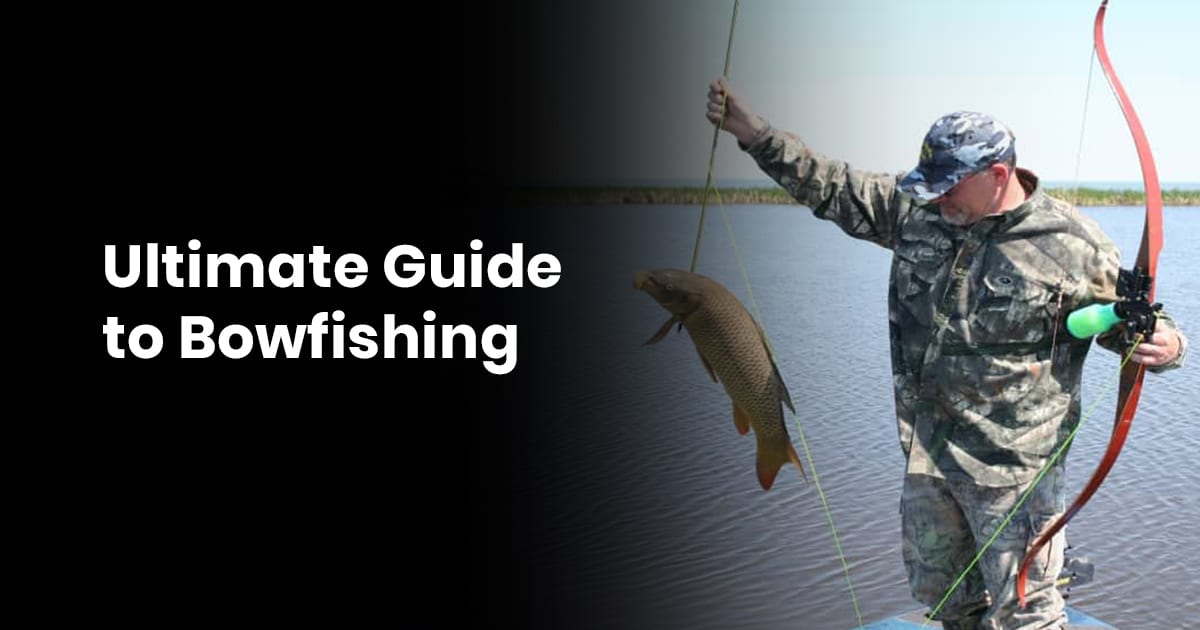How would you like to have a smoother transition from draw to releasing your arrow?
If you’re used to recurve bows and you’re making the jump to compound bows, you may be a little bit intimidated by bow releases.
You don’t have to hold the string back with your thumb and index any longer. Instead, use the power of a proper bow release to get the job done.
When you’re pinching the string and pulling pounds of pressure on the draw weight, you’re creating a bit of tension that could cause nearly invisible vibrations from the strain on your hand.
On your tenth consecutive shot, it could get even worse.
But there’s where the best bow release comes into play—it’s there to take all the strain off of your wrist, and put it onto the arrow, transferring your power into the shot and unleashing it towards your target with pinpoint precise accuracy.
A bow release not only works best for the sake of your hand, but it also lines up better shots, and increases your chance of landing your mark every single time.
Whether it’s game or standalone 3d targets, this is what you’ve been missing, and it’s time to set things straight.
Our Reviews Of The Best Bow Release
#1 TruFire Smoke Adjustable Bow Release
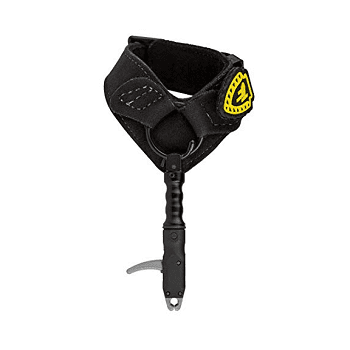
TruFire simply made the best archery release, and it’s clear to see why: they pay attention to detail.
Everyone has a different level of hand-eye coordination and steadiness of their hand, so TruFire gave you sixteen adjustable positions to maneuver your bow release, so you can always be firing at the top of your game.
Crafted out of durable nylon, this isn’t going to quit on you anytime soon.
You’ll have a durable rubber-like strap on the wrist, and the D-ring for the base of the release will be connected via two triple-stitched nylon straps.
Everything is fully customizable via a small allen wrench, one that you likely already have in your multitool.
What makes this so enjoyable is that it’s designed for comfort.
The nylon is cool and not abrasive on your skin, but the entire release mechanism is actually designed to flip around and run down your wrist instead of up.
That means when you’re not firing your bow, you can fold this back and it’ll just feel like a watch; it won’t be poking out and causing an issue.
As you might imagine, the very best model of anything is going to be expensive.
Well, psych—this is one of the most affordable releases, especially when compared against other TruFire releases (such as our second pick).
This is the bow release that’s going to make you fall in love with their brand. Quality, made durable, and designed to make your bow hunting a lot easier.
Technical specifications
- Material: Nylon
- Positions: 16
- Right/Left Handed: Ambidextrous
- Adjustable Trigger: Yes
- Made In: United States, Wisconsin
#2 TruFire Edge Buckle Release
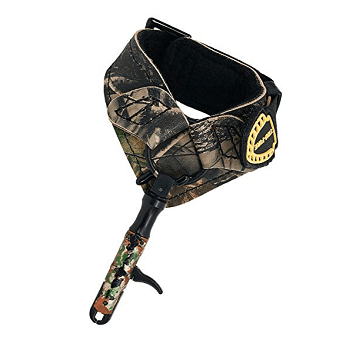
Bow release reviews usually target the wrist strap material over everything else, but TruFire wasn’t going to have any of that.
They just went with what’s best right away, and that happened to be leather.
This durable leather strap is plenty wide enough to cover your entire wrist, and add plenty of support to your hand while that string pulls back.
One of the most common issues with cheaply made releases is that they don’t feel stable while you’re on the drawback.
TruFire put their fantastic mechanism up to bat yet again, but they didn’t include as many adjustable positions, what was a bit odd to us considering their best-selling model contains it.
You can basically flip it so it goes down your wrist, which is great, or back to the simple draw/fire position.
The clasp closure is something you don’t want to mess with. It’s going to stay in place, come hell or high water, so position it accordingly when you suit up.
The only way we can really summarize how this feels when you press down on the release is smooth: it’s just like an extension of your already fantastic ability to shoot an arrow, but it’s just… smooth.
We were a bit perplexed at the pricing model for this one though, considering its predecessor model with arguably more features costs half the price.
We figured it was the inclusion of leather and preferences, but it made it hard to justify the price until it was actually on our wrists.
Technical specifications
- Material: Plastic, metal
- Positions: 2
- Right/Left Handed: Ambidextrous
- Adjustable Trigger: Yes
- Made In: United States, Wisconsin
#3 Hot Shot Vapor 4 Release
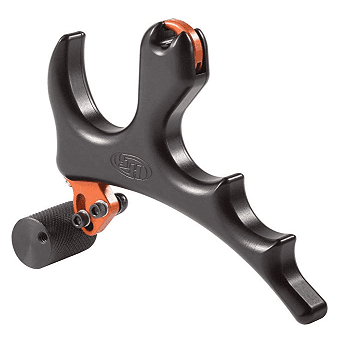
Hot Shot made a unique release, one that we’ve dubbed the best compound bow release, but it’s definitely something that’s out of the realm of normalcy.
For one, the strap style lanyard that goes around your wrist isn’t the most comfortable. It digs into you after a while, so it’s recommended to put this over an arm guard when firing.
Other than that, comfort almost hits a perfect 10/10. Almost.
They made this a full finger grip system, but when you get to the pinky rung, it’s like of like 3/4 the size it should be.
Not unusable, just a little short of hitting the mark. The rest of it feels like and smooth in your hand, and doesn’t require much movement at all.
It’s very loose-feeling (in a good way), so your hand is only closing about 30% onto it to keep your grip.
They use a blend of plastic and metal with this one, so you will see signs of wear and tear over time like grease spots from finger oil.
The thumb trigger is made of metal with a good cross-grid grip system woven into it, so you won’t feel it slip from your grasp at any point.
They do have a full metal version, but it is often out of stock.
So as you can see, it was a bit of a weird one to review.
It has its own unique features that we don’t usually see in bow releases, and it may be better suited for someone other than a few reviewers here who are used to the wrist strap leather and nylon blends.
Overall, a very solid piece with a truly ergonomic design.
Technical specifications
- Material: Nylon
- Positions: 1
- Right/Left Handed: Right-handed
- Adjustable Trigger: Yes
- Made In: Imported
#4 Scott Archery Caliper Bow Release
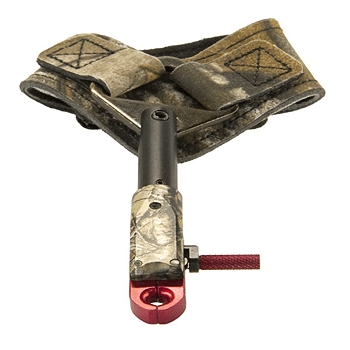
Scott Archery is one of the dedicated brands that are just trying to find a better way to enjoy archery, and crafting excellent products in the process.
This strap was a true treat to use from the moment we strapped the wide-fitting nylon around our wrists.
It comes in a blurry woodland camouflage that will blend in with your jacket sleeve, and won’t alert any prey (that’s the problem with all-black nylon usually).
It’s definitely the best hunting release with a camouflage finish, and the red metal jaw and release lever don’t take anything away from that.
It’s subtle, and keeps your release in your peripherals without it blending into the rest of the strap. After all, it’ll be behind the bow and string, so it won’t be noticeable to prey.
But nothing is perfect, and Scott Archery did quite literally fall short on one aspect—the trigger length.
Not the release lever, but the entire metal trigger tubing that you hold in your hand. It’s a wee bit short, so your fingertips still feel very close to the bowstring while it’s drawn back.
It’s a minor issue, but you will notice your fingers drifting further apart from the release the more you use this.
There’s a metal diamond-shaped ring that holds the caliper on, while the nylon straps simply hold it in place and attached to the main wrist strap.
It’s ambidextrous in design, as well as a 360° swivel, but it would have been nice if the trigger was a little more adjustable.
Nevertheless, it’s durable and reliable down to the last bit of pressure.
Technical specifications
- Weight: Nylon
- Positions: 360 degree swivel
- Right/Left Handed: Ambidextrous
- Adjustable Trigger: No
- Made In: United States
#5 TruFire Patriot Archery Compound Bow Release
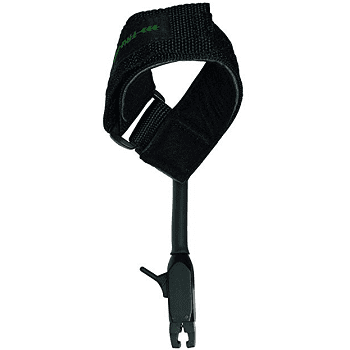
TruFire won the best archery hunting release top spot on this list, but we can’t ignore their super budget-friendly option, the Patriot.
It’s a simple nylon strap and release, but it gets the job done in the way that only TruFire can.
These are tested through 200 lb test weights on over 200,000 cycles to ensure everything runs smoothly, and that your bow release won’t fail you while you’re out on the trail.
The nylon is a bit roughly cut, but it doesn’t affect your wrist in the slightest, it’s just noticeably not the smoothest it could have been.
It’s secured on your wrist with a simple strip of velcro, so there’s no messing around with buckle tightness at any point during your hunt. Overall it’s pretty comfortable.
The design is ambidextrous and the trigger is fully adjustable, but it comes in a singular position, so keep in mind that you won’t be able to fold it back down your wrist.
No matter where you go you can’t find information about a bow release without seeing TruFire’s name pop up somewhere.
They made the jaw fully out of metal, giving it a sturdy design that won’t fail you, no matter how hard you try to run this thing through.
They guarantee this from its first shot well above its thousandth, making it a great release for newcomer competitive archers.
The price. You can’t beat the price, and while it’s normally indicative of quality (after all, you get what you pay for), TruFire didn’t cut corners on this.
They have a name to protect, and your have a bow to shoot. Get ready to welcome your partner in crime.
Technical specifications
- Material: Nylon
- Positions: 1
- Right/Left Handed: Ambidextrous
- Adjustable Trigger: Yes
- Made In: United States, Wisconsin
Bow Release Buying Guide and FAQ
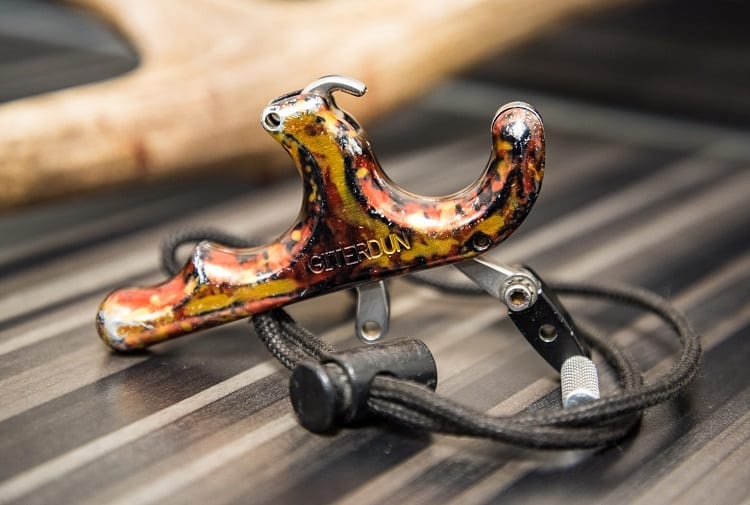
Benefits of a Bow Release
Reduces Risk of Trigger Thumb
Trigger thumb is no laughing matter; it can require surgery and long recoveries to handle. If you have diabetes or rheumatoid arthritis, you’re at a much higher risk of getting it.
To avoid the joint pain and physical harm, you need to put less pressure on your thumb/fingers. Well, a bow release is designed to do just that.
It lowers your chance of trigger thumb dramatically, and if you start using it young in your archery career, you may never run into that problem.
Protection
Apart from a medical condition, it’s also good for safety. If you’re using a recurve bow, then you know just how much bite is in the bark of a fully drawn back bowstring.
You have an arm guard for that, but your fingertips will definitely feel the burn from releasing a hundred 70 lb draw weight arrows on a Saturday morning.
You don’t have to rely on forming calluses; use a release instead.
Stabilization
At a certain point, your deltoids and core may be more ready than your wrist or arm muscles.
This could lead to some visible vibration on the string, and a shaky shot as you approach higher draw weights.
A good bow release will help you stabilize those shots so that they retain their high chance of hitting the target. There’s no shame in a bit of assistance from a trigger release.
Accuracy
Your chances of hitting the target will be higher. Not just for the aforementioned reason, but because it’s one less thing to focus on while you’re lining up your shot.
If it’s a simple tap away, you can keep your eye on the bullseye. There’s no tension in your hand, just in the moment. These will help you land better shots.
Can You Use a Release with a Recurve Bow?
Yes you should, and it’s recommended.
At a certain point of pressure, you might feel your arms wobble a bit, or notice vibration in the string as you try to shoot.
That’s normal, but it needs to be controlled. Getting the best bow release for accuracy will help you, and stabilize that little bit of give.
That’s going to give your straighter shots, and an overall smoother feeling.
Because recurves rely on your physical prowess to give draw weight, you can use all the help you can get.
Bow releases, as mentioned before, are a wonderful safety mechanism that all recurve bow users should consider adapting.
It’s used in the Olympics for a similar reason; those archers know just how much power they’re holding, and they don’t want it to bite them.
Do You Need a Release Aid for a Compound Bow?
It’s not required for a compound bow, but it is definitely necessary for a recurve.
Most archers will start on a recurve bow and come over to compound when it’s time to hunt or just to try something different.
At that point, we say if you’ve already been using one of the top bow releases on your recurve, you’d might as well carry that over to your compound.
The strings aren’t different on a compound; they react the same way, even if they may be made out of slightly different materials.
If you’re used to using a bow release, it’s going to give you a sense of familiarity and comfort when you pick up the compound.
Because a compound bow has a let-off of 75-80%, you only need to apply so much pressure to the string, so keep that in mind if you start using a release.
How to Use Bow Release?
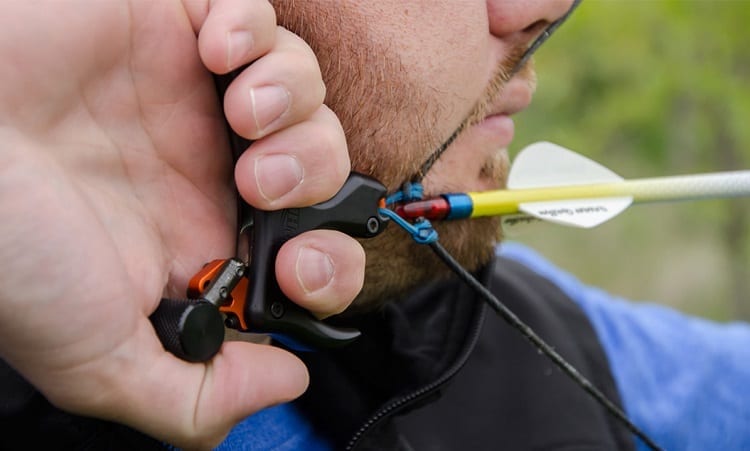
The best wrist releases feel nice and smooth on your wrist, like an extension of yourself.
You just have to let them work their magic.
You can use a bow release by first looking at the different types of releases below, and them circling back here.
For a thumb release, you gently hold your grip on the handle. You don’t want to squeeze too hard, otherwise you could fumble it and knock your thumb into it.
Clip the string in the jaws, pull back until you have reached the desired tension, and press your thumb down.
For an index release, you’ll strap the wristband pretty high up on your wrist near the bottom of your palm.
From there, swivel the metal caliper upwards so that there’s equal tension on both nylon/leather straps that hold the D-ring in place.
Attach the string to the jaws of the caliper, and pull back slowly. The trigger will be right next to your index, and it’s usually very sensitive.
Give it a quick flick when you’re ready, and the release will open the jaws and send the arrow flying.
For a hinge release, attach it to your wrist with the strap or hold it in your hand (some models are different here), and attach the string to the hinge.
Aim properly and ensure nobody is in the area, since you will not choose when this releases. Pull back on the string until you find the right tension.
Continue to add pressure slowly until the arrow is released (you have some control over this, but not much).
What are the Different Types of Releases?
Thumb Release
Thumb releases work by gripping your entire hand in a brass knuckle-like grip, and you use your thumb to release the arrow.
There’s a metal piece that hangs just underneath your thumb while the rest of your hand lightly squeezes the handle, and once you press down on that, it’s over.
This is used in competitive archery a lot because it offers slightly more control (basically not a hair trigger reaction) than an index release, though both are used across hunting and competitions.
Index Release
Just as you would imagine, your index finger is the one that flicks the trigger release. When you pull the bowstring back, the jaws hold onto the string until you decide to let it go.
The trigger is quite literally a flick away; you just move your index finger as if you were about to click on a PC mouse (only sideways), and it releases.
These are generally the most well-liked and viable picks for a bow release.
Hinge Release
These aren’t for hunting, and they aren’t for competitive archery. At the very best, they’re just something you can mess around with while you train archery.
These entirely handheld units cannot go on your wrist, and they pull the string back until enough pressure builds inside the caliper that it releases.
You do not control when it releases. If you decide to abandon the shot and slowly release tension on the string, it could still fire.
These aren’t recommended for anyone other than at least intermediate bow users, and they require a bit of extra safety.
True Aim is About Precision
Releasing your shots is half of the battle.
Line up your arrows, and get ready to release them with more accuracy and precision than ever before.
Expert bow masters will tell you that the release is where the full power of your strength and your body extend into the arrow, and the rest is up to the scientific calculations that you’ve rigorously gone through in your mind.
The release shouldn’t be strenuous on your wrist or hand, which is where the right release comes in—you’ll never want to shoot a bow without one again.
Did you like the article? Please rate it:


